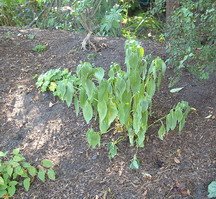


The September rains don’t seem to have materialized in my part of the world. 3/8" last week in the heaviest downpour of the summer and several shrubs on the berm at the back of the yard (see Hydrangea, pictured right,) are still in full wilt. Should I sit and write “Dallying” or should I go out and turn on the hose and try to rescue them. They will not make it through the winter unless they get a few good soakings between now and freeze up. That becomes an easy chore, as the rain barrels need to emptied before winter and the shrubs need to be watered, a winning combination. Enough about winter, there is still plenty of pleasant gardening time left this autumn.  My vision was to have the back berm covered with multi-coloured Crocus in the spring. This year I have 200 Lilac Wonder, an early species Tulip, (pictured right,) to try there. The word in the Walnut tree is that the ‘bttr’s’ prefer not to eat species tulips. The bulbs are quite small and much harder than the luscious large flowered types and they will get planted as deeply as possible 15 - 20 cm (6"- 8",) again counting on the laziness of my furry enemy. I haven’t used my power auger for several years; it might be time to resurrect it and see if it will create quick deep holes on the berm. I was never very impressed with this tool as it never seemed to actually remove much of the soil from the hole that it made and I still had to finish the job with the trowel. I’ll give it another shot.
My vision was to have the back berm covered with multi-coloured Crocus in the spring. This year I have 200 Lilac Wonder, an early species Tulip, (pictured right,) to try there. The word in the Walnut tree is that the ‘bttr’s’ prefer not to eat species tulips. The bulbs are quite small and much harder than the luscious large flowered types and they will get planted as deeply as possible 15 - 20 cm (6"- 8",) again counting on the laziness of my furry enemy. I haven’t used my power auger for several years; it might be time to resurrect it and see if it will create quick deep holes on the berm. I was never very impressed with this tool as it never seemed to actually remove much of the soil from the hole that it made and I still had to finish the job with the trowel. I’ll give it another shot.I have to admit to a terrible secret. I had a great deal of trouble growing carrots this year. Usually you spread the seed, water, wait, wander through the garden and eat on the spot. The third batch that I seeded finally gave me some results but they haven’t reached any significant size yet. I mention this because I had to go to the farmer's market and actually buy carrots for one of my favourite recipes. The garden is producing some quite nice cabbage this year and I have been harvesting them for some time now. Well, red cabbage is the other ingredient in this recipe. A colourful red and orange coleslaw. I also need some carrots, to add to my spaghetti sauce. I’ll try to have that recipe on 'gardening-enjoyed' soon. Dallying in the Dirt’s next issue will probably come from a different location. The Garden Writers Association is having their big annual meeting at the end of September in Oklahoma City. We will do some business, see lots of new products and plants and tour some wonderful gardens. I’ll take lots of pictures and notes and let you all know about the gardening delights of that part of the world. Oh yeah, we will probably socialize, (party, party, party,) a bit as well. There will be fewer reports about that part of the event. Questions My newsletter subscribers get to ask me questions. Just ‘reply’ to the email newsletter. It is always interesting to read the questions; mostly to see if I actually can answer them or if I have to wade into the textbooks to research the answers. If that happens then we all learn something. Nadia asks? When can lillium bulbs be moved and replanted? Ken Answers! Lilys just get bigger and stronger the longer they stay in one place. Sometimes, however, we just must move things. The easy answer to your question is, now. But you don’t need to hurry Lily bulbs can move around almost anytime in the later autumn until the ground gets too cold for them to start rooting. You will be amazed at how deep some of those bulbs have managed to get. Nadia (she was busy this week) also asks? I have a butterfly bush that has reached a height of about 61/2 ft.!! and has just started to blossom - is that an unusual height for this plant? I cut down my old raspberry canes as you instructed, some of this year's new shoots have reached 6ft. or so, do I chop them down somewhat too for the winter? Ken Answers! Wow! Everything in your garden grows to 6'. That’s a very good height for a Butterfly bush, Buddleia spp. you must have had a lot more rain than I did this year. My raspberry canes routinely grow that tall and I don’t shorten them. As long as you can find some way to keep them supported then you just have more cane to produce fruit next June. The weight of the berries will make them need a bit sturdier support than they need right now.  Paul asks? I have a Wisteria growing on the south wall of our house, I have failed to provide ample support for it to creep and now it is bunching up on the initial trellis. What do I do to get it back under control , cut it back ?
Paul asks? I have a Wisteria growing on the south wall of our house, I have failed to provide ample support for it to creep and now it is bunching up on the initial trellis. What do I do to get it back under control , cut it back ?Ken answers! A freshly purchased Wisteria looks like such a quiet little thing in its pot. They grow to be quite massive vines with large woody trunks. Cutting it back will temporarily get it under control. Proper pruning techniques to increase the flowering of Wisteria is a bit more complicated than I can answer here. I’ll try to get a page on those techniques on 'gardening-enjoyed' sometime soon. Your problem now is to cut it back enough so that you can construct a large solid trellis for this plant. It is going to grow heavy woody vines to at least 5 m (15ft) and needs some significant support. When they are in bloom they are magnificent. The flower buds are set in the fall and are frequently frozen off in cooler climates, Cdn. Zone 5 is usually pushing their limit. The vine will continue to flourish despite the frozen flower buds. The Wisteria pictured left bloomed near (unfortunately not in,) my garden this summer. Amazing aren't they. |
 Bulbs Bulbs Bulbs
Bulbs Bulbs Bulbs